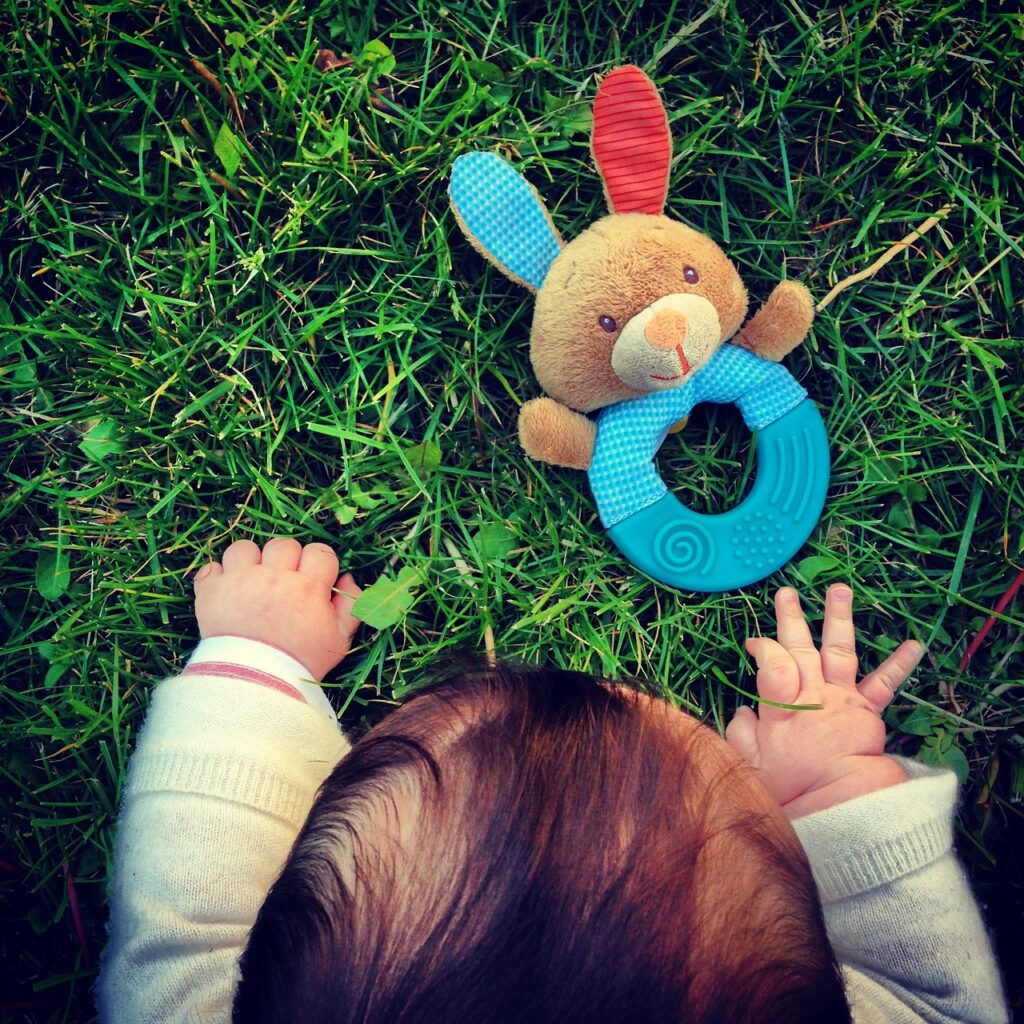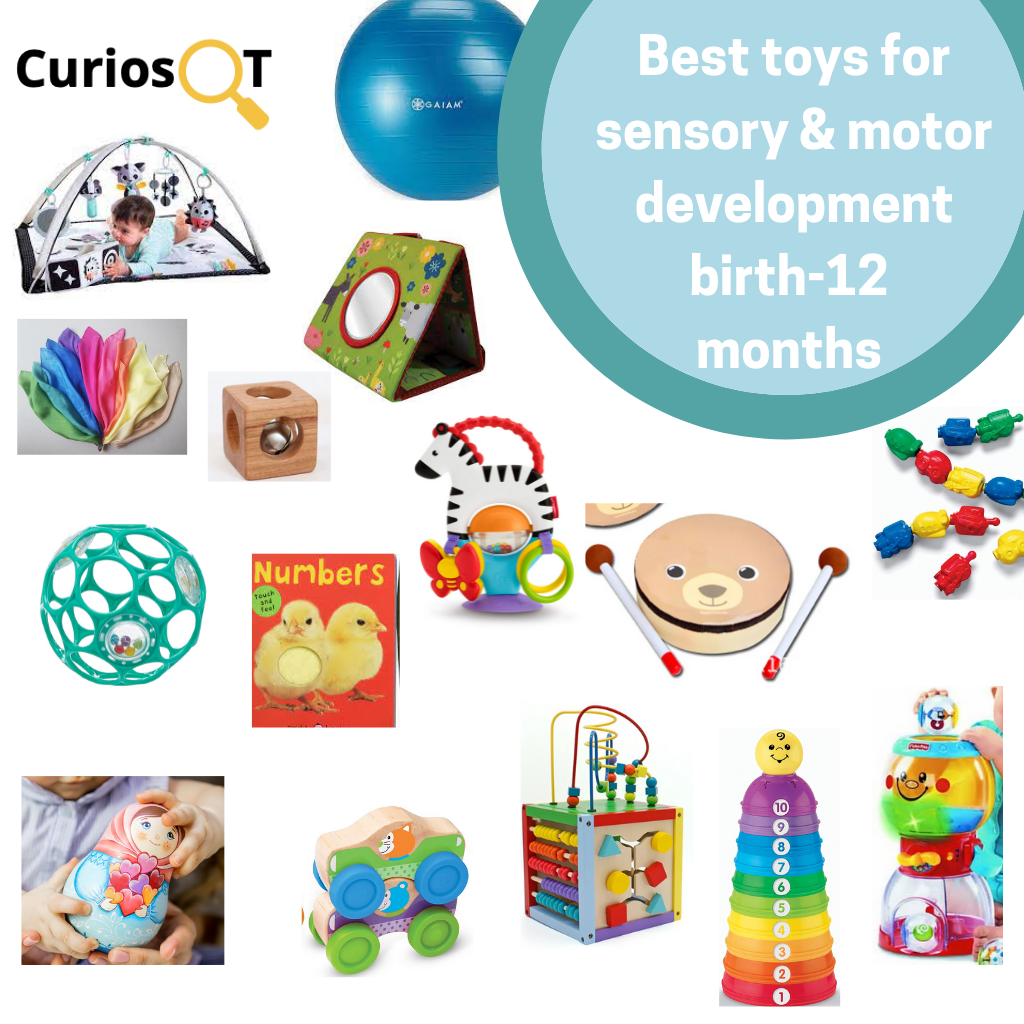
For young babies, their whole life is an abundant sensory and motor experience! They’ve exited the womb and entered the world, and often times they’re super excited for all of things that have become mundane to us.
So as far as toys go, I keep it very simple. I look for toys that are not over-stimulating, and that promote babies’ interest in moving, cause and effect, engagement, joy and exploration.
0-4 Months
- Yoga ball: When babies are not so mobile on their own, a yoga ball is a great way to introduce them to movement. You can sit and bounce while holding your baby, you can lay baby on his or her back and belly and do gentle rocking movements in all directions. Best part is this item can grow with your child. You can roll it, bounce it, etc. as they get older and bigger.
- Tiny Love Black and White Activity Mat: I thought I didn’t want an activity mat, but I’m super grateful we have this one. The black and white is great for when that’s about all baby notices. This mat comes with a nice little accordion set of black and white pictures which was great for our early tummy time days. The items that hang off of the hooks are simple and not overstimulating, and most importantly, I enjoy the little songs the hedgehog plays. That’s important for a toy that makes noise.
- Usborne Tummy Time Book: I am VERY excited for my mom and dad to bring this for my baby! I love it because it has a mirror, which is an awesome and perfect tummy time tool. It “grows” with your child as there are multiple sides to the book, which evolve into a cloth book with pages to flip, etc.
- Wooden Rattle with Bell: A friend bought this for my baby and it’s awesome. I like using wood/more natural and simple toys when possible. I like this one because baby can grasp it in the holes of the rattle, which encourages development of the muscles of the arch of the hand. And the bell is a more charming noise than plastic beads. Though, we have one of those rattles too. 😉
4-6 months
- Colorful scarves: I was with a mom friend the other day, and she brought these out for her 4 month old son, and I thought–brilliant. Colorful so baby’s interested, and scarves are a lovely form/texture for babies who are just learning how to grasp things. Basically they are pretty likely to be successful as opposed to when they are trying to grasp a more formed toy. Bonus is you can throw these in the dress up bin someday.
- O-ball teether: If you don’t know by now, OT’s love the O-ball. 2 for one. Teether and a ball. Also, the open web-like design allows for a little bit of help for little hands that are learning to grasp and use their fingers.
- Suction Cup Zebra Activity Toy: This guy is awesome. It’s one part teether, one part rattle, one part something to swat at. Bonus is that it has a suction cup, so you can attach it to a high chair, grandma’s table, the table at the restaurant etc. And there is a little rotating compartment with mini plastic beads that gives lots of cool visual sensory input.
- Touch and Feel & Crinkle Books: These books are lovely. I always have to touch every texture myself, lol. As baby starts swatting at things, they’ll be (hopefully) delightfully surprised to explore interesting textures. Bonus is that baby can help turn the pages with chunky board books.

6-9 Months
- Roly Poly Musical Toy: This toy is great to encourage more controlled/directed swatting from baby during tummy time as well as crawling. Light bells or chimes is the old school way to teach baby cause and effect with auditory sensory input (pre push a button, toy plays music)
- Melissa & Dough Stackable Animal Wooden Cars: Someone gifted us these, and I already use them with baby during tummy time. They’re fun because you can stack them. So I often will roll it across the mat to work on his visual tracking and then stack them up and knock them down to address his attention and cause/effect play. As he gets older, he’ll be able to roll them, knock down other things with them, etc.
- Hand Drum: Another great way to introduce music for natural sensory input along with an opportunity for baby to play at midline while using both hands together to bang away as they improve their aim with their hands.
- Activity Cube: I like this for (at least) two fold reasons. One is that as your baby is getting more sturdy during tummy time, they can use a cube like this to challenge their shoulder stability as they reach up off the floor. It’s also a great toy for your baby as they look for something to play with while sitting up. This particular cube allows you to take off the twisty-twirly maze, which makes this a great activity to practice dropping items into a container.
9-12 Months
- Large Pop Beads: Being that baby is sitting or on their way to being a more sturdy sitter, using two hands to do something a little more challenging will work on their core, shoulder and hand strength.
- Fisher Price Stack & Roll: This is seriously one of my all time favorite toys as a pediatric therapist. I use it with kids of so many different ages. It’s awesome because the “cups” that nest together also push together to form balls of varying sizes. So you can work on rolling the ball to each other, rolling to knock things over, etc. The stacking is nice because they “click” so they’re more sturdy than other stacking toys. They are a little challenging to push and pull apart to make the balls, so mom or dad will have to help with that for now.
- Fisher Price Gumball Drop Toy: Dang, I really like Fisher Price’s toys for 9-12 month olds, lol. This one (though it has lights and music…you could choose to not put in batteries. Baby won’t know the difference) is super fun because baby will work on refining their ability to release items into a large opening as well as pushing down a lever to release the ball down the ramp. The balls are all very cute with captivating sound or visual input.
Phew!
There you have it. Those are my recommendations for toys that are unique/worth keeping around the house that will also bring baby joy as they develop their sensory and motor skills. Share this post with a new mama who is also looking for toys she won’t regret buying!
If you have other big kids (12 months to 8 years old!) don’t forget to check out my suggestions for them too! You can find each post broken down by age here.






